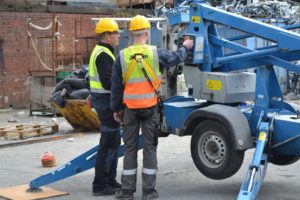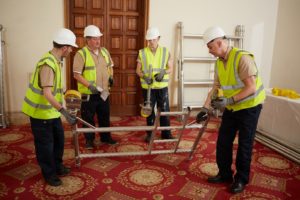Workplace fatalities
Industry measures to reduce workplace fatalities in the UK
Recent statistics show an increasing rate of deaths in the workplace, between 2018/19 in the UK. 147 deaths were reported to enforcing authorities, urging companies and government bodies to do more in preventing workplace fatalities.
 The UK has consistently had a lower rate of fatal work-related injuries than any of the other large economies across the EU. However, certain sectors still have room for improvement. With more initiatives and focus placed on proper safety training, we can and will reduce workplace injuries and fatalities.
The UK has consistently had a lower rate of fatal work-related injuries than any of the other large economies across the EU. However, certain sectors still have room for improvement. With more initiatives and focus placed on proper safety training, we can and will reduce workplace injuries and fatalities.
Common causes of fatal accidents in the workplace
Statistically, what is the leading cause of a fatal accident at work?
- Fall from Height – 40%
- Struck by a moving vehicle – 30%
- Struck by moving object – 16%
- Contact with moving machinery – 14%
- Trapped by something collapsing/overturning – 11%
In 2019, falls from height were the single largest factor for fatalities in the workplace. Broken down by industry sector 21.8% of deaths were in the agriculture, forestry, and fishing industries, 20.4% in construction and 17.7% in manufacturing.
The Health and Safety Executive (HSE) advises that ‘companies should consider the prevention of these types of death to be a health and safety priority’.
Industries that require employees to work at height, should take this advice into high consideration, as figures show that falling from height fatalities increased 14.3% year on year, from 35 to 40 deaths.
Additional annual statistics, published by the HSE in October 2019 (estimated at 2017 prices), indicate a human cost of £1,250,000 and financial cost of £436,700 equating to a total cost of £1,687,000 per case. The ‘human cost’ reflects the family ‘pain, grief and suffering’ associated with losing a loved one in such a devastating way.
Working at Height and Brexit
 In the wake of the UK Brexit decision, in 2019, the publication of an Inquiry Report ‘Staying Alive’, published by an All-Party Parliamentary Group (APPG) on Working at Height.
In the wake of the UK Brexit decision, in 2019, the publication of an Inquiry Report ‘Staying Alive’, published by an All-Party Parliamentary Group (APPG) on Working at Height.
APPG is ‘calling on the Government to ensure that no individual working at height will be any less safe as a result of Brexit’.
The inquiry highlights that ensuring a company’s ‘safety culture’, is in line with health and safety best practice and guidelines and plays a pivotal role in reducing the likelihood of a fall from height.
Factors that can negatively impact this culture are creeping ‘complacency’ when an individual becomes inured to the risk and potential consequences of a fall. The APPG believes that the best way forward is to ensure that accidents and ‘near misses’ are adequately reported, along with investigating the introduction of civil enforcement.
Managing Director at Boss Training, Andrew Murphy, said: “Whilst strides have been made in guaranteeing the safety of employees within the workplace, more must be done in the coming years.
“The recent figures regarding fatal accidents in the workplace are disheartening to say the least and there are several steps that employers can take to vastly reduce the chances of severe accidents occurring in the workplace.”
Reducing workplace fatalities
The key to reducing accidents in the workplace is being able to identify which areas your business should target first, by doing this you can effectively minimise the risk of injuries and fatalities within your place of work.
Training
 Educating, or re-educating, all of your staff on best practice when it comes to health and safety. Whilst it’s mandatory in some lines of work to regularly carry out health and safety training courses, in some sectors, health and safety best practices are only taught in the induction period for employees and not regularly maintained.
Educating, or re-educating, all of your staff on best practice when it comes to health and safety. Whilst it’s mandatory in some lines of work to regularly carry out health and safety training courses, in some sectors, health and safety best practices are only taught in the induction period for employees and not regularly maintained.
It’s definitely recommended that you take the time to put in a regular and robust health and safety training schedule and invest in training from accredited health and safety professionals.
Andrew Murphy said: “The importance of regularly sending employees on health and safety courses relevant to their job role cannot be understated.
“Simply allowing your staff the time to update on the latest health and safety legislation and best practices through professional training is one of the very best way to minimise the risk of accidents and emergencies in the workplace; and in the unlikely event that an accident does occur, employees will be better equipped to deal with the situation in line with current best practices.”
Fines
Aside from carrying out more health and safety training, raising fines for malpractice and failure to work within health and safety guidelines may also be a good solution and is something that companies need to be aware of.
Whilst there are obviously huge financial repercussions for any companies that have serious injuries or fatalities within their workplace, it’s probably worth considering more substantial fines for smaller health and safety breaches.
With £72.6 million in fines resulting from health and safety offences prosecuted by HSE in 2017/18 and £15 billion in annual costs for work-related injuries and new cases of ill health in 2016/17, neglecting health and safety is costly for both businesses and the country as a whole.
While the UK has consistently had a lower rate of fatal work-related injuries than any of the other large economies across the EU, certain sectors still have room for improvement. With more initiatives and focus placed on proper safety training, we can and will reduce workplace injuries and fatalities.
Industry measures to reduce workplace fatalities in the UK
Recent statistics show an increasing rate of deaths in the workplace, between 2018/19 in the UK. 147 deaths were reported to enforcing authorities, urging companies and government bodies to do more in preventing workplace fatalities.
Safety & Health Practitioner
SHP - Health and Safety News, Legislation, PPE, CPD and Resources Related Topics
Gogglebox star George Gilbey died after fall through skylight
Company fined after worker fractures skull
Work at height charity launches ‘No Falls Week’




111% of deaths in total if you add your percentages up.